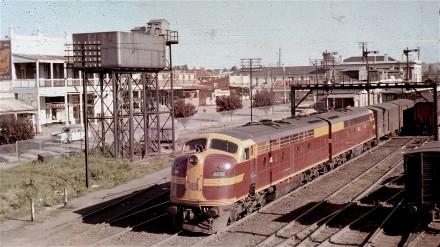
New South Wales 42 class locomotive
Encyclopedia

Clyde Engineering
Clyde Engineering was the name of part of the business now known as Downer EDI Rail. Clyde Engineering were involved in the construction of railway locomotives and rolling stock, as well as larger scale engineering projects on behalf of the governments of Australia...
at Granville, New South Wales
Granville, New South Wales
Granville, is a suburb in western Sydney, Australia. Granville is located west of the Sydney central business district, in the local government area of the City of Parramatta. A small part in the north-west is located in the Local Government Area of the City of Holroyd.South Granville is a...
for the New South Wales Government Railways
New South Wales Government Railways
The New South Wales Government Railways was the government department that operated the New South Wales Government's railways until the establishment of the Public Transport Commission in 1972. Although later known officially as the Department of Railways, New South Wales, it was still generally...
between 1955 and 1956. Six locomotives were built numbered 4201–4206. They were built with the classic "bulldog nose
Bulldog nose
"Bulldog nose" is the nickname given, due to their appearance, to several diesel locomotives manufactured by GM-EMD and its licencees from 1939 to 1970...
", and while similar in appearance to the 421 class, the 42 class do not have a second cab at the rear of the locomotive.
The locomotives have an EMD 16-567C
EMD 567
The EMD 567 is a line of diesel engines built by General Motors' Electro-Motive Division. This engine, which succeeded Winton's 201-A, was used in EMD's locomotives from 1938 until its replacement in 1966 by the EMD 645. It has a bore of , a stroke of and a displacement of 567 in³ per cylinder...
motor developing 1,305 kW (1,750 horsepower), EMD D12 generator, and six EMD D37 traction motor
Traction motor
Traction motor refers to an electric motor providing the primary rotational torque of a machine, usually for conversion into linear motion ....
s The 42 class have a top speed of 115 km/h, have a length of 18.54 m, and weigh 122 t. These locomotives ride on Co-Co bogies and operate on standard gauge.
The current status of these locomotives are:
- 4201 - Preserved at New South Wales Rail Transport MuseumNew South Wales Rail Transport MuseumThe New South Wales Rail Transport Museum located in Thirlmere, New South Wales south-west of Sydney, is a museum dedicated to displaying former locomotives, carriages and goods wagons from the New South Wales Government Railways as well as private operations in NSW. The collection features steam,...
, Thirlmere, NSW - 4202 - Scrapped
- 4203 - Preserved O'Donohugue's Pub, Emu Plains, SydneySydneySydney is the most populous city in Australia and the state capital of New South Wales. Sydney is located on Australia's south-east coast of the Tasman Sea. As of June 2010, the greater metropolitan area had an approximate population of 4.6 million people...
- 4204 - Preserved at Lachlan Valley RailwayLachlan Valley RailwayThe Lachlan Valley Railway Society Cooperative Limited is a non-profit rail preservation society based in the NSW Central Western town of Cowra, New South Wales, Australia. The museum's ex-NSWGR fleet ranges from their operational steam and diesel locomotives, to the fleet of heritage passenger...
and operational - 4205 - Scrapped
- 4206 - Preserved at Dorrigo Steam Railway and MuseumDorrigo Steam Railway and MuseumThe Dorrigo Steam Railway and Museum in Dorrigo, New South Wales, Australia is a large, privately owned collection of preserved railway vehicles and equipment from the railways of New South Wales, covering both Government and private railways...
Modeling
The 42 class was produced in HO scale ready to run by Lima. A more accurate version was produced by Trainorama in April 2010 in HO scale as a ready to run model as well.Tyco made the 42 class along with the s class as a retool of there f9. they were not very acuurte
Further reading
The 42 Class of N.S.W. Morahan, M Australian Railway Historical Society BulletinAustralian Railway History
Australian Railway History , is the premier magazine covering railway history in Australia...
, January/February, 1985 pp1–24;26-43

